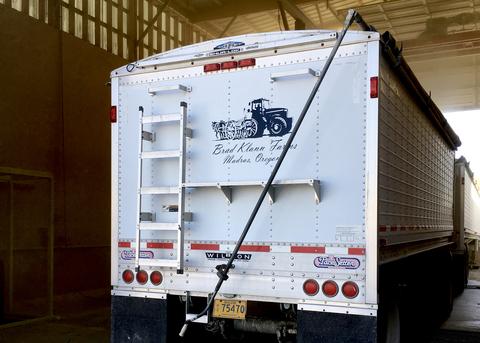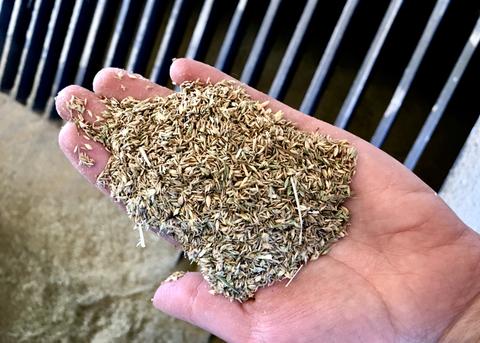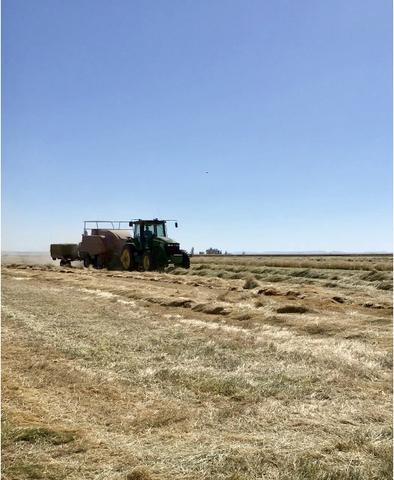Our family comes from a long, unbroken line of agriculturists, reaching back to the original Luelling \loo·ell·ing\ family, who were Quaker plantation owners farming in North Carolina before the Revolutionary War. They also happened to be staunch abolitionists, which didn't set well with their slave-owning neighbors. As the Civil War loomed near, the family pushed westward, establishing an orchard and several Underground Railroad stops in the town of Salem, Iowa. Without written records it is difficult to count the number of slaves that the Lewellings helped escape from Missouri.
In 1847, Henderson Luelling filled two wagons with charcoal, manure, earth and 700 grafted fruited trees: including apples, pears, plums, cherries, quinces and grapes. In spite of everyone's advice that he would never make it across the Plains - Henderson, his entire family, and about half of the original 700 grafted fruit trees survived their journey on the Oregon Trail. Luelling established his orchard on 100 acres in the community of Milwaukie, Oregon, which is now the site of the Waverly Country Club.
The first fruit from the orchard was picked in 1851. The population of Portland at the time was 851 people, most of them apparently salivating for fresh fruit...Luelling sold his first trunkful at $1/apple. In today's money, that would be $30/apple. Ultimately, Luelling's fruit trees became the parent stock of most of the orchards in Oregon's Willamette Valley. He is considered the father of the Pacific Northwest fruit industry. In 1875, Henderson's brother and partner, Seth Lewelling (along with head orchardist Ah Bing) were responsible for grafting the still-popular Bing cherry. In 1999, Seth Lewelling was inducted into the Oregon Association of Nurseries Hall of Fame and in 2019 Henderson Luelling was inducted.
Henderson's grandson, named after Seth Luelling, married Cora Ellen Converse, a local farm girl from McMinnville, Oregon on September 16th 1896, at the local parsonage. Eight years and three children later, they decided to move from their farm in Viola, (Near present day Oregon City), to establish a new farm north of Madras, on the Agency Plains as part of the Homestead Act. On September 1st, 1904, they loaded up their four horse wagon, along with Seth’s brother Johnnie who rode on horseback driving cattle, and headed eastward over the Cascade Mountains. After a weeks of traveling, stopping each night to rest, they reached the Deschutes River, where they crossed over on the ferry and traveled up a long steep grade, finally arriving on the Agency Plains, on October 10, 1904.
Camping on their neighbor’s homestead in a tent, Seth went hunting on horseback looking for a claim of land to file on. Finally, an old and aging bachelor by the name of Frank Ringo, relinquished his claim to them, so the family moved their campsite and put down their roots on October 18th. Cora and their children grubbed out sagebrush by hand, cleared fields of volcanic rock, and hauled water from a spring in wooden barrels in order to carve out their new home, while Seth and Uncle Johnnie hauled in lumber and materials to build their homestead, while also farming. That April, Seth and his brother sowed their first crop of grain and created an additional gardening area. On June 6, 1905, Seth filed a homestead claim on 160 acres. Life was tough for Madras' first settlers, but the Luellings persevered, raising cattle, wheat, potatoes, and a family of six children (Ellen, Johnnie, Lloyd, Chester, Mary, Roy).
By 1911 the Oregon Trunk Railroad was completed and in 1912, Seth purchased additional farm acreage from the Monners and Larsons. With the increase of acreage came the need for machinery so in 1917, he bought his first auto, a Ford and a combine that required 8-10 horses to use while harvesting. An additional 320 acres (Davis Place) was purchased on January 15, 1919, from Hiram Links. On October 2, 1921, Ellen, one of Seth's daughters, married a local, neighboring farm boy, Fred Klann. Chester, one of Seth’s sons, moved away from the homestead in 1922 and worked on the construction of roads as a heavy equipment operator.
By 1927 things got slightly easier for the high desert homesteaders when domestic water was piped to all farmers on the Agency Plains from Opal Springs and an irrigation district was formed. Irrigation water was due to come to the Jefferson County area when the North Unit Irrigation Project was completed in four to five years. When the district was formed, the Bureau of Reclamation made all landowners sign an agreement to dispose of all land they owned in excess of 80 acres that would be irrigated with the newly acquired water rights. In 1929, Seth and Cora purchased the “Ferguson Place,” making their total acreage of tillable farm ground to date be 1200 acres. Because of the water agreement, Seth and Cora gifted each of their children 80 acres, and the remainder of the land that could be irrigated had to be sold when water arrived.
Chester and his wife Amy came back in 1937 and farmed the Ferguson, Davis and Hanna places. The following year, Seth put all his work horses up for sale and bought his first rubber tired John Deere tractor and Chester built a house on the west side of the Ferguson place. Construction on the North Unit Project began on July 21, 1938, but was stalled due to the arrival of World War II. On July 13, 1939, Seth Luelling passed away. His wife Cora continued on, purchasing the 120 acre “Hanna Place,” in 1942. The North Unit canal was completed in 1946 and water was delivered to 17,000 acres during 1946 and 1947 south of Madras. By the summer of 1948, all 50,000 acres, including the farm, were receiving water, quickly transforming the community into a mecca for specialty crops.
With the completion of the NUID, the land was split between the Luelling children as follows: Chester, 80 acres “Ferguson Place.” The “Davis Place,” was split between; Ellen 80 acres, Johnnie 80 acres, Mary 80 acres and Cora 80 acres. Cora also kept the west 40 acres of the homestead place. Lloyd owned the remainder of the homestead and “Hanna Place,” and Roy owned the “Monner” and “Uncle Johnnie’s Place.” Between 1948-1953, the “Davis Place,” was rented out and overlooked by Ellen, Johnie, Mary and Cora to a person to put ditches in and get the irrigation started. In 1949, Cora had Harold Klann build a house on her 80 acres for whoever rented the Davis Place. In 1950 Ellen Klann had a house machine shed built in which Jim Klann moved into in 1952. Three years later, Jim Klann, Ellen and Fred Klann’s son, started farming “Ellen and Johnie’s Places” and Cora’s 40 acre homestead piece, for a total of 200 acres.
After coming home from the service, in 1953, Harold Klann, son of Ellen and Fred Klann, started farming Mary and Cora’s 80 acre parcels, living in the rental house Cora and him built. The next year, Lloyd Luelling sold the east 120 acres of the original homestead and also the “Hanna Place,” to Hershel and Jesse Gregg. In 1960, Jim Klann, quit farming and Harold took over what Jim had been farming. By 1970, Harold had acquired all 360 acres by purchasing farmland from his aunts, uncles, mom and Grandma Cora Luelling.
Brad Klann the current owner of Brad Klann Farms, started farming with his parents Harold (son of Ellen and Fred) and Imogene Klann on the 360 acres his father had been farming since coming home from the service. In 1976, they replaced most of their flood-irrigated ground with two of the first center pivots in Jefferson County and two wheel lines. To supply them with water, a large pond was built to store and capture water from neighboring farms' flood fields. Water-use efficiency and conservation remain key components of the Klanns' farm.
After marrying Debbie (the girl-next-door, who also happened to live in the Monner Place) on September 24th, 1983, Brad started renting and buying neighboring acreage in addition to what he was farming with Harold in the corporation. In 1987 he purchased 160 acres, known as the “Whitaker Place,” and following in 1994 he purchased Cora Luelling’s 80 acres from Harold, who also moved from the farm into town. Harold retired from farming in 1995, the corporation was dissolved and Brad farmed the remaining 280 acres they had shared. In 2000 Brad started renting an additional 160 acres, “Chester’s/Ferguson Place,” where he installed a new pivot with a corner irrigation system. 2003 brought the purchase of an additional 320 acres, 160 acres being “Chester’s,” and the 160 acre “Gregg Property,” south of his home, where he also installed a new pivot.
By the time their children Seth and Katie went off to college, they were farming close to 840 acres. 4-H and FFA are a large part of the family history: Harold, Brad, Seth, Katie and Sally (Seth's wife) were all members, with Seth serving as an Oregon FFA State Officer in 2003-2004 and Katie serving in 2005-2006. Seth and Katie both attended Oregon State University after being State Officers, where Seth graduated with a degree in Graphic Design and Katie in Interior Design. Weeks before graduation in 2008, Seth decided not to pursue a career in design and chose to come home to farm with his father Brad.
On February 26, 2011, Seth and Sally were married. That September they purchased the original Seth Luelling homestead, which included the homestead house, barn and 120 acres, plus 120 acres of the old “Hannah Place,” which had been farmed by the Greggs from 1954-2009. The original homestead and Hanna property had been out of the family for over 60 years. Seth began farming as Mecca Grade Growers, in conjunction with Brad Klann Farms. At the beginning of 2012, Brad and Seth were looking for additional help farming, so Katie’s fiancé Travis Ralls, began farming with them. On May 19, 2012, Katie and Travis were married on the original family homestead. That year Seth also put up a new 1/2 pivot on the Luelling Homestead. In 2014 Brad purchased 80 acres (Mary’s/1919 Davis Place) from Klann and Son’s Corporation and the following year, in 2015, Seth purchased and started farming 200 acres (160 acres of 1919 Davis Place/Ellen and Johnnie’s and 40 acres of 1905 Cora’s Homestead) from the Harold Klann Trust.
Always looking for new innovative ways to add value to the farm led to the start of an Estate Malt plant on the very same ground the Klanns’ family homesteaded. In 2015 they started building a malting house facility on the Seth Luelling Homestead and created, Mecca Grade Estate Malt, owned by Brad and Seth Klann.
Today, Brad, Seth, and Travis are farming 1080 irrigated acres utilizing mostly overhead pivot irrigation. The entire family lives on the farm within a 2 mile radius of each other. Seth and Sally live with their three sons, Jet (7), Silas (6) and Cash (4) in the original homestead house. Brad and Debbie live in Harold’s original home built in 1949 and Katie and Travis, with their daughter Merit (1), are building a home on 40 acres of the Whitaker Place Brad purchased back in 1987.
Over the years, the Klanns have raised many crops: potatoes, alfalfa hay, radish seed, peppermint for oil, Echinacea, St. John's wort, carrot seed, ryegrass, alfalfa seed and Kentucky bluegrass seed. Currently, they raise Kentucky bluegrass seed and use winter peas as a cover crop. They also raise DNS wheat, 2-row spring barley, soft white wheat and spring rye for malting











